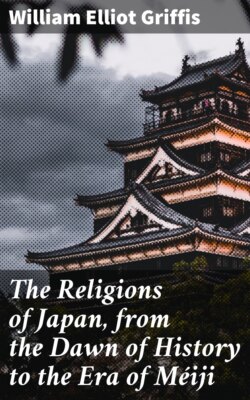Читать книгу The Religions of Japan, from the Dawn of History to the Era of Méiji - William Elliot Griffis - Страница 24
На сайте Литреса книга снята с продажи.
The Ancient Documents.
ОглавлениеTable of Contents
The first book, the "Kojiki," gives us the theology, cosmogony, mythology, and very probably, in its later portions, some outlines of history of the ancient Japanese. The "Kojiki" is the real, the dogmatic exponent, or, if we may so say, the Bible, of Shint[=o]. The "Many[=o]shu," or Book of Myriad Poems, expresses the thoughts and feelings; reflects the manners and customs of the primitive generations, and, in the same sense as do the Sagas of the Scandinavians, furnishes us unchronological but interesting and more or less real narratives of events which have been glorified by the poets and artists. The ancient codes of law and of ceremonial procedure are of great value, while the "Norito" are excellent mirrors in which to see reflected the religion called Shint[=o] on the more active side of worship.
In a critical study, either of the general body of national tradition or of the ancient documents, we must continually be on our guard against the usual assumption that Chinese civilization came in earlier than it really did. This assumption colors all modern Japanese popular ideas, art and literature. The vice of the pupil nations surrounding the Middle Kingdom is their desire to have it believed that Chinese letters and culture among them is an nearly coeval with those of China as can be made truly or falsely to appear. The Koreans, for example, would have us believe that their civilization, based on letters and introduced by Kishi, is "four thousand years old" and contemporaneous with China's own, and that "the Koreans are among the oldest people of the world."5 The average modern Japanese wishes the date of authentic or official history projected as far back as possible. Yet he is a modest man compared with his mediæval ancestor, who constructed chronology out of ink-stones. Over a thousand years ago a deliberate forgery was officially put on paper. A whole line of emperors who never lived was canonized, and clever penmen set down in ink long chapters which describe what never happened.6 Furthermore, even after, and only eight years after the fairly honest "Kojiki" had been compiled, the book called "Nihongi," or Chronicles of Japan, was written. All the internal and not a little external evidence shows that the object of this book is to give the impression that Chinese ideas, culture and learning had long been domesticated in Japan. The "Nihongi" gives dates of events supposed to have happened fifteen hundred years before, with an accuracy which may be called villainous; while the "Kojiki" states that Wani, a Korean teacher, brought the "Thousand Character Classic" to Japan in A.D. 285, though that famous Chinese book was not composed until the sixth century, or A.D. 550.7
Even to this day it is nearly impossible for an American to get a Korean "frog in the well"8 to understand why the genuine native life and history, language and learning of his own peninsular country is of greater value to the student than the pedantry borrowed from China. Why these possess any interest to a "scholar" is a mystery to the head in the horsehair net. Anything of value, he thinks, must be on the Chinese model. What is not Chinese is foolish and fit for women and children only. Furthermore, Korea "always had" Chinese learning. This is the sum of the arguments of the Korean literati, even as it used to be of the old-time hatless Yedo scholar of shaven skull and topknot.
Despite Japanese independence and even arrogance in certain other lines, the thought of the demolition of cherished notions of vast antiquity is very painful. Critical study of ancient traditions is still dangerous, even in parliamentary Nippon. Hence the unbiassed student must depend on his own reading of and judgment upon the ancient records, assisted by the thorough work done by the English scholars Aston, Satow, Chamberlain, Bramsen and others.
It was the coming of Buddhism in the sixth century, and the implanting on the soil of Japan of a system of religion in which were temples with all that was attractive to the eye, gorgeous ritual, scriptures, priesthood, codes of morals, rigid discipline, a system of dogmatics in which all was made positive and clear, that made the variant myths and legends somewhat uniform. The faith of Shaka, by winning adherents both at the court and among the leading men of intelligence, reacted upon the national traditions so as to compel their collection and arrangemeut into definite formulas. In due time the mythology, poetry and ritual was, as we have seen, committed to writing and the whole system called Shint[=o], in distinction from Butsud[=o], the Way of the Gods from the Way of the Buddhas. Thus we can see more clearly the outward and visible manifestations of Shint[=o]. In forming our judgment, however, we must put aside those descriptions which are found in the works of European writers, from Marco Polo and Mendez Pinto down to the year 1870. Though these were good observers, they were often necessarily mistaken in their deductions. For, as we shall see in our lecture on Riy[=o]bu or Mixed Buddhism, Shint[=o] was, from the ninth century until late into the nineteenth century, absorbed in Buddhism so as to be next to invisible.
